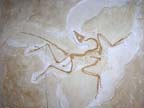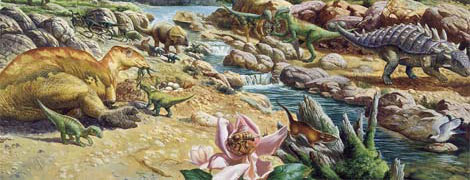 |
 |
 |
 |
 |
Produced
by the Population Genetics and Evolution class, Furman University |
||||
 |
 |
 |
 |
 |
Produced
by the Population Genetics and Evolution class, Furman University |
||||
 |
The
Cretaceous: Quetzalcoatlus |
 |
||
| Quetzalcoatlus
were enormous pterosaurs or reptile-like creatures that flew with their
large webbed wings. Fossils records reveal that their wings provided a
large amount of upward thrust for their massive bodies because they spanned
about twelve meters in width (UCMP 2010). Even though they depended greatly
on their wings for movement, discovered hind limb tracks show evidence
that they had the ability to rest and hunt on the ground (Witton et al.
2008). These extinct creatures were believed to be carnivorous because
their large, keratinized beaks would allow for the tearing of flesh. Due
to the weak vertebral support in their necks, scientists think that Quetzalcoatlus
strictly hunted its prey in terrestrial environments (Witton et al. 2008).
Quetzalcoatlus was also believed to have been a migratory species;
which could be evolutionarily important because birds at that time, and
even today, displayed migratory patterns (Kellner et al. 1996). Their
well-adapted and highly specialized traits for flight and feeding made
Quetzalcoatlus a feared predator on land and in the sky.
Page by Pete Calomiris |

|
| Quetzalcoatlus, human and Giraffe.Picture From: toptenz.com | |
|
Waggoner B. 1995. Introduction to Pterosauria: The Flying Reptiles. Berkley University of California Museum of Paleontology. Accessed April 2010. Kellner AW and Langston W. 1996. Cranial Remains of Quetzalcoatlus (Pterosauria, Azhdarchidae) from Late Cretaceous Sediments of Big Bend National Park, Texas. Journal of Vertebrae Paleontology. Accessed April 2010. Witton MP and Naish D. 2008. A Reappraisal of Azhdarchid Pterosaur Functional Morphology and Paleoecology. PLoS ONE. Accessed April 2010. |